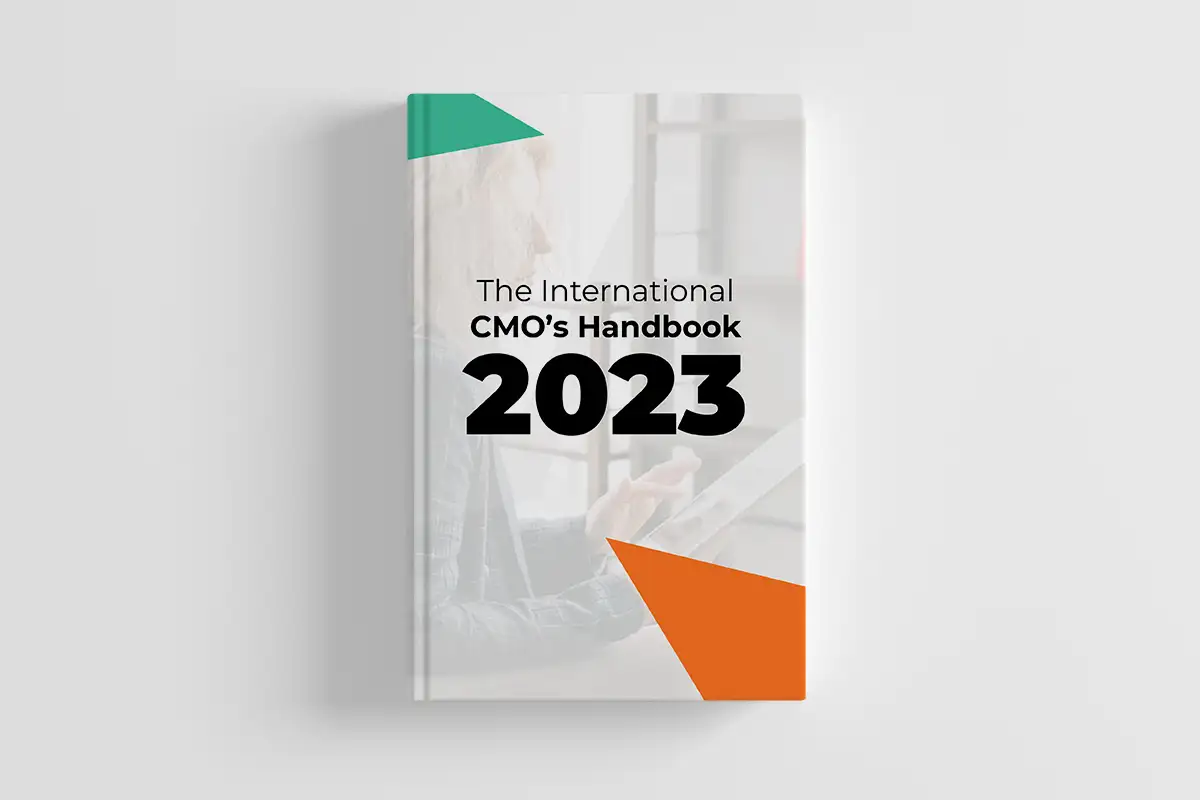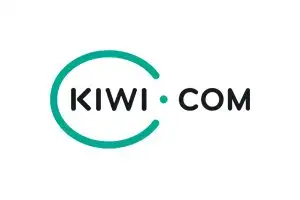Expert advice on expanding your business with confidence
Despite today’s interconnected world with its low barriers for cross-border trade, international expansion remains risky . Getting it right is as challenging as ever, learning the hard way can cost you hundreds of thousands of dollars.
Taking those first steps into a new market often falls to the Chief Marketing Officer. But even the most seasoned CMO can falter without experience in international expansion.
The 2023 International CMO Handbook aims to demystify some of this process. We interviewed a selection of global CMOs in late 2022. Our goal was collating a set of practical advice you can use to plan a smoother expansion for your organization.
Huge thanks to everyone involved in creating the handbook.

Table of contents
In this document we’ll be exploring…
Spotting the potential to expand
Exactly where you choose to expand will depend on your business’s resources and the nature of your product or service. Each market’s unique characteristics also play their role.
We recommend asking yourself:
- Which countries have the largest clusters of people interested in what you do?
- Where is competition most (and least) fierce?
- Which markets will accept your product as it is right now?
- Could your existing partners help de-risk expansion into any market?
- What are the legal and data privacy frameworks like in potential markets?
- Could culture and language differences affect how you’re perceived?
- What markets offer the most reliable logistics and supply options?
- How different are tax laws and trading standards to your home market?
- How is your brand already perceived in a potential market right now?
Who’s already interested in your product or service?
You can spot where your next big audience might be, by using:
- Google Trends data
- Google keyword research
- Trending topics on social
- Meta interest groups segmented by geographical market
We helped a client do this for their ethical handmade children’s footwear business. Reviewing European markets for localized versions of important keywords identified countries with the greatest export opportunity.
What markets have the most potential from a purely quantitative point of view? Think about GDP, raw market research, as well as demographic and income data. Aim to get a true representation of size.

”Miroslav Rozenberg, CMO at Probinex expresses how important this point is in the crypto industry. Adoption of crypto varies greatly from country to country. Audiences generally exist in highly specific online and offline subcommunities.
Probinex focuses on finding and contacting these segments, that’s where the highest probability of success is. Their whole enterprise’s brand image and awareness is tied to the quality of their research.
What’s the competition up to?
Conduct a deep competitor analysis. Where are you in relation to price, placements, positioning and product? Which markets house the fiercest and weakest competitors?
When Kiwi.com did this, they found the USA market was problematic. Competition was high, ads were expensive and less effective. Sure, the US is a market with many upsides, but the high cost of acquiring customers meant it was never going to be their most lucrative location.
Which markets are ready for your product without alterations?
When UFC organized one of their first German events in 2009 , the market wasn’t prepared for mixed martial arts. We had to do a lot of ground work to raise the profile of the brand and the local fighters.
The formula we developed to warm up new markets has worked brilliantly since the lessons of those early days. By 2022, using the same process, we were helping launch UFC’s first Paris event. Gane vs Tuivasa became their 24th consecutive sellout, with an attendance of 15,405 and total announced gate of $3,242,837.
”Matthew Corry, CMO at Kugali, says: “The markets we work with are often untapped and unknown; emerging, frontier, or even classified as least-developed countries (LDC). There’s often very little data on sales, demographic splits or consumer interests. Getting that data from anecdotal or on-the-ground research can be prohibitively expensive and time-consuming.
“Instead, we build models using data from similar markets. We then enter each market with a product that can be sold to other markets if that one fails. It makes our approach performance-active and highly responsive to data.“

Can your existing channel partners or networks help?
Your current connections might have data, insights or opportunities that could help you enter a new market.

”Bhavesh Vaghela, CMO of ActiveOps, a financial services B2B software company, says: "I won a deal which opened up a whole new territory for us to enter. Our channel partner, Microsoft, helped us acquire one client in Japan, a new market for us. We had no prior experience there, it’s a difficult market to enter.
"Winning this client de-risked our expansion into the Japanese market, because we learnt so much from this single large client. We made alterations to the product and learned how the Japanese do business. It gave us sufficient understanding to position ourselves for this market before entering fully."
Are the legal and privacy frameworks different in a potential new market?
Think about what legal loopholes you could have to jump through before you start operating in a new market. Product marketing restrictions, trademarks, labor protections or tax laws might affect your profitability.
We work with share trading companies who have to comply with evolving legislation for every country they enter. Post-Brexit changes also have consequences for British businesses trading with Europe, and vice versa.
Don’t forget federal restrictions surrounding privacy. Be sure to respect laws governing how businesses use personal data. The EU’s General Data Protection Regulation (GDPR) and the California Consumer Privacy Act (CCPA) in the USA both impact your ability to remarket with personalized ads.
This isn’t only a CMO’s issue. Sales and legal departments have responsibilities too. In particular, ask if it’s financially beneficial to use a local bank account? How will you transfer money between the local business and your headquarters?
A market’s potential could be limited without access to an experienced advisor. Find someone with local knowledge who can help administer the financial side of business in the best way for you.
Respecting culture and language shows you mean business
It goes without saying that you should show proper respect to your new customers’ culture. Assumptions can be costly.
”The USA is an underestimated market. Hiring good people can be harder in the US.
ActiveOps’ Bhavesh says: “The USA is an underestimated market, it’s difficult because you think it’s similar to other English-speaking cultures. The truth is, it’s different and it presents its own challenges. Hiring good people can be harder in the US.”
The fine details of how each country does business are also vital. It’s especially important to understand local payment methods for ecommerce business. We’ve seen countless such businesses increase conversions by localizing their sales funnels.
Miroslav Rozenberg recommends a book, The Cultural Map by Erin Meyer. It guides the reader through the nuances of communicating and doing business with people from contrasting cultures. It’s not only about understanding culture, geographically. It is important to understand also culture of the company.
“Some CMOs will be great in small start-ups, some in middle-sized businesses and some in big corps. Pep Guardiola could never coach Brighton :)))”
Language is another sensitive area. We meet marketing teams selling products internationally without understanding how to localize websites or adapt advertising to local languages.
A Canadian baby product business contacted us. They’d been running Meta ads using a piece of software which translated into several European languages. They were also losing tens of thousands each month. An audit revealed how, in some instances, words had been auto-translated and made no contextual sense. That contextual sense is everything. Hiring the right translators – or local copywriters – can make or break an international expansion.
Consider logistics and supply in prospective new markets
Can you establish reliable supply chains in a new market so goods are available when and where you need them? Your sourcing department might appreciate extra time or resources to establish relationships with local procurement experts.
Those logistics might also have to go two ways. Consider customer returns, an area where consumer confidence can evaporate fast. Research shipping providers and costs to ensure your existing policies reflect the services you can offer in new markets.
If shipping across borders, the official guidance is usually to identify drop-shipping or warehousing partners. If you’re planning to ship overseas directly from your country, customers need to know customs-related fees and delivery times.
Ensure all relevant departments are consulted, and that your web content team is always up to date with policy changes.
Importantly, think what the local supply of labour is like. Promising markets are often ones with plenty of experienced local talent to bring on board.
What are trading standards and tax laws like in your new market?
Customs and tax regulations could have a significant impact on your ability to competitively price your products or services. Make this one of the first things you or your colleagues in legal and finance check. VAT changes post-Brexit are important considerations for UK exporters.
Bhavesh Vaghela from ActiveOps says: “I found out how complicated US tax systems were after entering the market. We had to build a new payment process for each state. This set us back a considerable number of months”
A new market’s trading standards might also be different to your own. If you don’t meet these standards, you can lose customers or end up breaking the law. Look at whether standards like the International Organization for Standardization (ISO) are used. Seek local legal advice when in doubt, rather than falling afoul of local laws.
”I found out how complicated US tax systems were after entering the market.
Is the conversation about your brand already happening?
Consumer surveys can tell you a lot about how your brand is already perceived in a new market.
”Philippe Ruttens, CMO of Tyk advises: "Research real or perceived product-market fit gaps in your target market and create detailed profiles of customer (ICP and Personas). Email surveys and interviews let you learn first-hand what your target audience think about you and competitors, as well as their specific JTBDs and pain/gain points. This will tell you where revenue opportunities are."

Belén from Urban Sports Club emphasizes knowing clearly what channels audiences use to learn about new products. Tools like Facebook Audience Insights and Google In-market Audiences can help you understand the potential size, demographics, interests and behaviors of audiences you can reach online.
The depth and quality of your research should identify high-risk, low-return markets to avoid. It will also show you where the best opportunities are. With this established, it’s time to forge your go-to-market strategy.
Creating an international go-to-market strategy
The international expansion process typically comes in three different forms:
- Step-by-step expansion
- Large scale multi-country expansion
- Growth via an enabler
Step-by-step expansion
Businesses going from national to international generally take their first steps carefully. Those without the resources or internal capabilities of larger organizations can still scale via a different, steadier path.
Choose one, or a small handful of new territories. Enter incrementally via a series of tests, tweaking your campaigns in line with emerging data. Over time, you’ll draw conclusions about the target market, the most effective channels, and how the locals perceive your brand.
This gradual process will eventually lead to the right market fit.
Inch Blue
There are countless examples of businesses taking this approach; Lego, Walmart and Tesco all managed it. But a children’s footwear client of ours, Rhiannon from Inch Blue, stands out as an excellent example.
Inch Blue scaled from humble beginnings. After becoming a major UK player, founder Rhiannon saw an influx of cheap Chinese competitors enter the market. That started to negatively impact their growth.
To open up new sales avenues, Inch Blue set sights on Germany and France. We stepped in to support this expansion. A steady process of testing, learning and optimizing generated massive amounts of actionable data. Even further expansion into new territories is now on the table.

Large scale multi-country expansion
Big companies with tremendous amounts of resources can enter multiple countries at once. This can be hugely costly. For example, entering 10 new markets means a tenfold increase in costs like:
- Website localization
- Target audience analysis
- Payment system fees
- Ad campaigns
- Legal fees
- Establishing logistics and supply chains
- Local consultants
Many businesses expanding into new markets endure financial losses during the learning and optimization phase. Expanding into 10 new markets would mean 10 times the potential losses.
However, when executed properly, these large-scale expansions can be terrifically profitable. We’ve been lucky enough to work on several such expansions.

UFC
We helped UFC with their expansion plans across Europe: Raising brand awareness, acquiring new fans, increasing social engagement, selling event tickets, driving TV viewership.
After considerable upfront research and collaboration with the UFC marketing team, we built a multi-channelled approach localized for each market. The result was sold out events in the UK, Germany, Sweden, Ireland, Poland, Netherlands, Denmark, the Czech Republic and Croatia.
Growth via an enabler
You don’t necessarily have to expand alone. If one of your clients, partners, or even suppliers is expanding, they may still need your services in order to deliver theirs.
If this is the case, expanding alongside such an enabler can significantly de-risk the move to a new territory. Bhavesh from ActiveOps experienced this himself. They had to adapt their software for a new market, but they did so on behalf of an existing client’s expansion.
Ultimately, they got paid to grow. It de-risked this important milestone for the company and set up conditions to win more clients in that market.
Enablers can show up in surprising places. Ex-clients or colleagues now active in different markets can prove to be powerful allies.
Tactical tips for smoother expansion
Establishing a go-to-market strategy sets the stage for tactical considerations. The fine details of making an expansion successful can’t be ignored.
Experience has shown us these tips can take a lot of the sting out of international growth.
Calculate your brand vs performance marketing split
If you’re totally unknown in your new chosen market, brand building will have to lead the way. Adjust your KPI expectations, lower ROAS targets while you establish your presence.
Run test ad campaigns
Test campaigns can give you an inexpensive sense of the market’s readiness for your product or service. These campaigns can be used to bring traffic to your website, testing ad copy and design changes.
Carry out keyword research
Is your new market looking for sneakers, trainers, or gym shoes? Trousers or pants? Carry out thorough research in the local language(s) and dialect(s) to optimize key website landing pages for organic search.
Use culturally sensitive creative
Don’t stand out for the wrong reasons. Align your visual ad creative with your new market’s demographic profile.
That might mean appearing as though you’re native to the new market. It might mean looking like a big international company which nevertheless has a trustworthy understanding of the new territory. Either way, the goal is reassurance.
Configure your ad accounts’ setup
Should you set up a single Facebook or Google Ads account for each country? Or run ads from one global account? Weigh the pros and cons. As well as convenience, you’ll need to take currency, time zones and tracking into consideration.
Configure your analytics setup
Your analytics platform needs to handle all the reports stakeholders need to see. Enable cross-domain tracking if users will be moving between your localized websites. Aim for a unified view of how people interact with your websites and subdomains.
Set up your Facebook Pixel across all websites
Best practice is to have one common pixel across all your domains. This makes pixel code maintenance easier, particularly useful if you plan to run multi-lingual ads across different domains and use cross-border lookalike audiences to fuel growth in the new markets. One exception to this would be if you are required to keep distinct business entities for different markets.
Monitor your advertising budgets
Every market behaves differently. Until you start your campaigns in new countries, it’s impossible to tell exactly how efficiently your budget will get spent. At first, play it safe. Set budgets that reflect the audience size. Monitor frequency rates and impression share data carefully until you’re confident.
Provide customer service channels
How can potential and existing customers get in touch with you? Will they be able to do so in their own language? Check what customer service channels a prospective market traditionally prefers. Use them if possible.
Keep yourself informed
National news stories and trends can create opportunities for sales. Knowing the public mood in a new market can also help you mitigate problems and fine-tune marketing messaging.
Identify local peak periods
Sales and big shopping days aren’t the same everywhere. Research a prospective market’s seasonal peaks and troughs.
Localize your website
A customer’s confidence in your website makes or breaks a sale. Design, layout, messaging, and tone all need to be tailored to each specific market. Display prices in the local currency. Provide phone contact numbers with local codes at local rates.
If your website doesn’t match the cultural assumptions of a new market, you risk standing out for the wrong reasons.
Localize your order process
As well as making your order, checkout, and email processes as familiar and comfortable as possible, think about payments. Use locally established payment providers and be sure you can accept payment in your customers’ preferred currency.
Try your best to accommodate locally preferred payment terms if possible. Some Eastern European and Asian markets rely heavily on cash, cheques or credit terms.
Localize automated communications
Make sure you can segment within your CRM. Consider creating newsletters in each market’s language. That goes for promotional emails too if you’re in ecommerce.
Get established on local social networks
Customers expect to find you on social media. Ask yourself whether it’s practical to manage local pages for each market. If you opt for one global page, remember that Facebook, WhatsApp, and YouTube aren’t necessarily popular or even legal everywhere.
Look beyond the usual platforms. There’s WeChat in China, VKontakte (VK) in Russia, Line in Japan; the German-speaking professional platform Xing has 19 million users.
Plan for local link building
Being completely reliant on paid media to drive traffic can get costly. Aim to build links from trusted, relevant local sites.
Find PR opportunities with local media
Learn the local media outlets who align best with your brand. Find the right people to build relationships with. News, opinion, comment, interviews, or case studies can all help position you as a trusted expert.

”Miroslav Rozenberg, formerly of Kiwi.com stresses the importance of getting PR right as part of global expansion. "We created a holiday price index where we compared prices of plane tickets per country all over the world. We built data per country on accommodation cost, drinks, food; everything a traveler would need.
"Journalists picked up the idea, it achieved massive reach all over the world with major publishers. It resulted in over 200 press releases in multiple countries, generating massive amounts of traffic and brand awareness."
Research competitors’ media exposure
Use tools like Mention, Meltwater, or Google Alerts to get a sense of the existing local media landscape. This can help you spot media outlets that fit your brand, and learn how companies in your space are perceived.
Build an organic community
Set up a Facebook group for your first customers in new target markets. Properly incentivized, they can become brand evangelists and help grow the community for you.
Measure brand recognition
Quantify the impact of your brand awareness building campaigns at least every six months. Think about metrics like brand lift, branded search volume data, survey results, website traffic and social media data.
Create Google My Business listings
Google My Business is free, and trusted in nearly 250 countries. Pack your listing with high-quality images and all the details you can provide. Encourage customers to leave reviews.
Invest in technical multilingual SEO
Aim to get found organically. Establish a top-level domain presence with the right hreflang declarations to serve the correct pages on search results in the local language.
Develop a culturally sensitive content strategy
Get intimately familiar with the cultural nuances of each market. Adapt your messaging and your content appropriately.
Thoughts from the AccuraCast team
We’ve helped a number of businesses successfully expand into new markets. Hear what some of our team have to say about making the CMO’s life easier during this process.
Tell us about your experience in international marketing?
“Since founding AccuraCast, I’ve been part of every international campaign over the past 20 years. We’ve marketed in over 100 countries by now. The past decade has seen a rapidly growing number of businesses looking to grow internationally, and technology is making it much easier.
“In fact, international growth is a necessity for UK businesses. There’s a finite amount of growth potential here, compared to vast opportunity overseas.”
What are some of the most overlooked elements of international expansion?
“Using your own local data when breaking into new markets. You can make some highly informed assumptions based on what you already know, and fine-tune your approach from there.”
What advice do you have for businesses expanding internationally?
“Make sure there’s a market fit. Then once you’ve determined there’s a fit, test to see if the market is actually ready for you.
“If not, decide if you want to let someone else invest in getting the market ready before swooping in. Of course, that only works if you’ve got a superior product or service. Either way, don’t forget to invest in branding over performance in the early days of any expansion.“
Farhad Divecha
Managing Director
Jerome Bergerou
International Director
Can you share some of your insights and experiences in international marketing?
“I’ve managed campaigns for both large and medium-sized companies. Brands that grow through acquisitions find it difficult to build unified campaigns. Making every business unit work in harmony can be harder.
“Brands that are growing from a home base often struggle to be relevant outside their home market. Particularly when faced with a different competitor landscape.”
What elements of international expansion sometimes get overlooked?
“Data is key. Leverage the data you already hold to break into a new market. Use your existing audience profiles to find similar customers in new markets. This needs to be expanded with branding campaigns to grow further, of course.”
What advice do you have for businesses expanding internationally?
“Logistics and customs arrangements have to be at the forefront. You can’t beat the local competition while being hampered by customs charges or slow delivery.
“At the same time, you need to test the market. You can usually tolerate a transition period where you bed into a new location based on a smaller marketing budget.“
Advice from our network of CMOs
Guidance from our network of successful global marketing experts.

How should businesses prepare themselves for cross-border expansion?
“Research is key. Use your network; talk to prospects, customers, and channel partners. Picking up the phone or sending a LinkedIn message is cheap but the payoff can be huge. Build your go-to-market strategy, but be flexible as your research starts to pay off.
”Short-term scarifies can massively increase the amount of vital early-stage feedback.
“Win a customer before entering a market fully. Overdeliver for them and learn as much as you can from the experience. Reflect on what you’ve learned and adjust the tactical elements of the expansion. Having a market fit in your home territory isn’t the same as in a new market, you have to earn it and it takes time.”
When entering a new market, what goals should you set for the first year?
“Above all else, focus on winning that first account and learning from them. In some cases, it’s worth giving the service away for free. Short-term scarifies can massively increase the amount of vital early-stage feedback.“
Bhavesh Vaghela
CMO of ActiveOps, a B2B software company supporting backend work processing for financial services businesses.
Miroslav Rozenberg
CMO at Probinex, a cryptocurrency business, and former Head of Growth for Kiwi.com, a travel platform.


What advice do you have for businesses expanding internationally?
“The nature of your audience can have a dramatic effect on how you approach expansion. For a crypto business like Probinex, regulation analysis is vital. Our investors exist in niche online subcommunities, we don’t simply aim to expand into a specific territory. For us, success lies in finding these large clusters of users and taking our geographic lead from there.
”Make sure you partner with, consult, and hire people who have been there and done it
“When I was at Kiwi.com, on the other hand, our audience was far broader. We could focus on winning handsome percentages of whole continents’ market share. In this, local knowledge is essential. Make sure you partner with, consult, and hire people who have been there and done it in the market you are expanding into.“

What advice do you have for CMOs expanding overseas?
“Don’t underestimate how important it is to understand the differences in foreign cultures at local or regional levels. For example, Europe is a maze of diverse languages, topics and business cultures. Equally, doing business in AMER and APAC are completely different experiences. The former is more dynamic and to-the-point, while the latter requires local partners to position your brand competitively.“
”Build genuine knowledge about your customers, and don’t take your eye off what the competition is doing
What should a business prioritize for its first year of expansion?
“With your ICP & sector research, build a matrix of ICP x JTBD (jobs-to-be-done) matching your brand and product differentiators. Use your own and third-party buying intent data to get more focus, keep testing & optimizing your content and tactics and be agile about your approach every single day. While in your learning stage, don’t be afraid to adjust your commercial goals based on prospect & customer data, engagement and conversion insights.
“Build genuine knowledge about your customers/ICP, and don’t take your eye off what the competition is doing while not simply copying them. You can learn a lot from simple observations in demo calls, SDR feedback coupled with a strong data-based framework.“
Phillippe Ruttens
CMO of Tyk, a leading API management platform & gateway scale-up helping product & engineering teams grow revenue & efficiency.
Matthew Corry
CMO of Kugali Media, an entertainment company focused on telling stories inspired by African Culture using comic books, art and augmented reality.

What advice do you have for other businesses expanding internationally?
“We work with emerging markets; profitability often can’t be an immediate concern. Instead, CPAs and user numbers can help spot a market’s potential. We prioritize that growth potential over hard-and-fast profitability.
“It’s also a good idea to ask yourself the hardest questions first. If you’re releasing an app to a frontier market, do any of its functions rely on online connectivity? Is it designed to run on current tech, can you release versions for older tech to ensure accessibility?”
”If the infrastructure to support your business doesn’t exist in a potential market, be prepared to build it.
“Payment issues also often get neglected. What protection methods are there for payments, and do those payment processes properly cater to the potential user base in the area? Is the app prohibitive to those without banking access?
“If the infrastructure to support your business doesn’t exist in a potential market, be prepared to build it. From an ethical perspective, business practices aimed at entering these markets must also contribute to their development.”
Summary:
Learning from experience
International expansion is different for every business, but some aspects are similar. Any expansion calls for considerable upfront research into areas like:
- Local laws
- Logistics
- Target market analysis
- Effective sales channels
- Competitor analysis
- Privacy regulations
- Cultural and language differences
The best opportunities are those where you can be competitive in as many of these areas as possible. No market is perfect, your research will balance risk vs reward. From there, you can expand either:
- Step by step into one market
- At scale into multiple markets
- Via an enabler, into one or more markets
From all the valuable contributions made to this guide, three big themes have emerged:
- Don’t underestimate cultural and language differences. Hire locally and partner with people who know the both the target market and the full international expansion process.
- Do your research, your early expansion phases should focus on learning about your customers instead of raw sales.
- Be flexible, test the market and use feedback to refine your approach instead of sticking to prior conclusions.
As barriers to doing business across borders continue to get lower, businesses get more and more options. Those who manage to successfully expand will be those who set themselves apart with a solid strategy, and respect for every new market they enter.
Ready for growth?
Contact us to find out how our range of digital marketing services can help your brand grow on a global scale.









